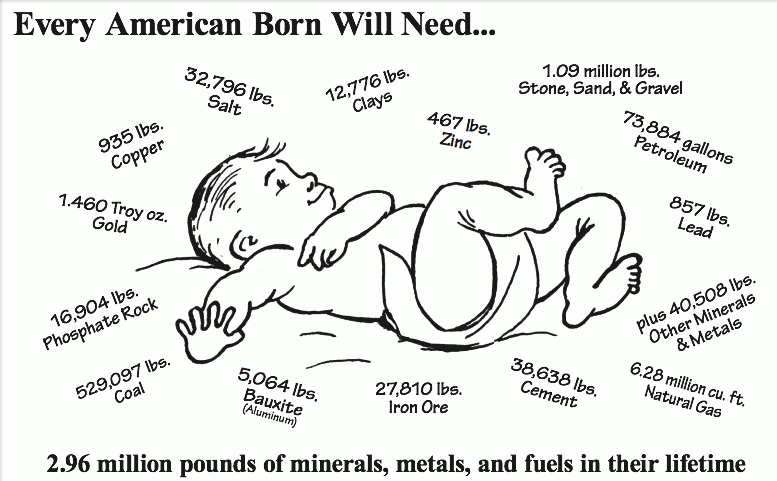38,052 Pounds of Minerals For Every American Last Year
Last year, every person in the United States needed more than 19 tons of minerals and energy fuels to maintain their standard of living, according to statistics compiled by the Mineral Information Institute (Mii), an affiliate of the Society for Mining, Metallurgy and Exploration Foundation.
With the life expectancy in the U.S. averaging 77.9 years, the average American will need to have 2.96 million pounds of resources to provide the products and materials they will depend upon in their lifetime. The population of the U.S. is over 308 million people, so this means that last year nearly 6 billion tons of rocks and minerals had to be mined somewhere to make the things we use in our everyday lives.
According to the U.S. Geological Survey, in 2010 the value of mineral production increased in the United States, suggesting that the domestic nonfuel minerals industries, especially the metallic mineral industries, were beginning to feel the effects of recovery from the economic recession that began in 2007.

Minerals’ contribution to the GDP was more than that of 2009, but below that of 2008. Continued declines in the construction industry were reflected in further reductions in the production and consumption of cement, construction sand and gravel, crushed stone and gypsum. Performances in other sectors were mixed and less easily characterized.
Despite these conditions, more than 38,000 pounds of mined materials were needed per person in 2010 to maintain the American lifestyle. More than half (21,675 pounds) of the country’s mineral needs involve energy fuels required for transportation and to heat, cool and light our homes and businesses. Energy fuels include coal, petroleum, natural gas and uranium. Each year the Institute uses information provided by the U.S. Geological Survey, the Energy Information Administration and the National Mining Association to calculate the amounts of different rocks and minerals that are mined to make the things we all use.
Process for Calculating the Mii Minerals Baby
Per Capita Annual Consumption
To annually update the Mii Minerals Baby, statistics from the U.S. Geological Survey Mineral Commodity Summaries (annual reports are available on-line at http://minerals.usgs.gov/minerals/pubs/commodity/) and the Energy Information Administration (http://www.eia.doe.gov/) provide the amounts of various minerals and energy fuels that are consumed in the United States. Both sources provide annual “apparent consumption” data that is used, rather than production statistics.
The Statistic Services group of the National Mining Association provides the analysis to generate the per capita mineral usage by converting these statistics from (in most cases) metric tonnes to pounds and dividing by the most current U.S. population estimate. (This report is available on-line at http://www.nma.org/.) This provides the U.S. Annual Mineral Use Per Person statistic. To provide a weight statistic, the petroleum and natural gas numbers are converted from volume to weight measurements.
To Create the Lifetime Statistic
This annual per capita consumption is multiplied by the average life expectancy for newborns in the U.S., provided by the Center for Disease Control. The life expectancy statistic between men and women was averaged by CDC, and the figure of 77.9 years was used in calculating this year’s Mii Minerals Baby.
Examples of how those minerals and metals are used
The average American house contains slightly more than a quarter of a million pounds of minerals and metals; there were nearly 130 million housing units existing in the country in 2010. Each of them requires insulation (silica, feldspar and trona), roofing (silica sands, limestone and petroleum) and hardware (iron, zinc, copper, steel, brass). Glass windows are made of trona, silica sand, limestone and feldspar. Foundations consist of concrete made from sand, gravel and cement. Cement is made of limestone, bauxite, clay, shale and gypsum. The concrete is reinforced with steel rods.
- There were an estimated 255,917,664 registered passenger vehicles in the United States in 2010, each weighing an average of nearly 3,000 pounds. Each is driven more than 12,000 miles a year and consumes an average of 550 gallons of fuel annually.
- There are 4 million miles of roads and bridges in the country that require maintenance and repair. 85,000 tons of aggregates are required for each mile of interstate highway.
- More than 131 billion cans are produced each year; about 63% of the steel cans and 52% of the aluminum cans are recycled.
- More than 1.4 billion cinema tickets are sold each year, requiring energy fuels to heat and cool the audience, operate the projectors and to provide the snacks at the more than 39,000 theater screens in the U.S.
- Eighty-eight percent of the electricity used in the U.S. is generated by fuels obtained by mining: 47% from coal, 20% from natural gas and oil, 21% from nuclear power. Only 7% is generated by hydro, with another 5% from geothermal, solar, wind and biomass combined.
- There were 1.28 billion cell phones sold worldwide in 2008, each containing about $1 worth of gold, plus 42 other minerals and metals.

